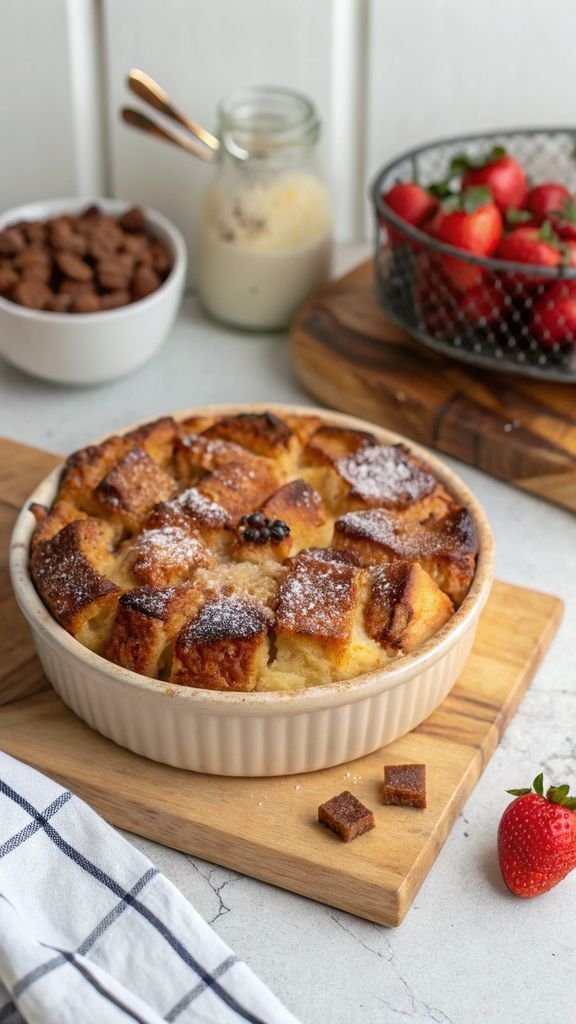Ultimate Comfort: Classic Bread Pudding with a Twist
There’s something undeniably magical about transforming stale bread into a luscious, custardy dessert that feels like a warm hug. Bread pudding—a humble dish born from frugality—has traveled through centuries and continents, evolving from a simple peasant food to a beloved comfort classic. Its origins trace back to 11th-century Europe, where it was known as “poor man’s pudding.” Cooks would soak leftover bread in milk and eggs to soften it, then bake it to avoid waste. As it crossed the Atlantic, it absorbed local flavors: bourbon in the American South, maple syrup in New England, and cinnamon-spiked apples in the Midwest. What fascinates me most is how this dish represents culinary alchemy—turning something dry and overlooked into a decadent, soul-warming treat. My own food memory involves my grandmother pulling her version, studded with raisins and smelling of nutmeg, from her ancient oven on snowy evenings. Today, bread pudding remains a canvas for creativity, whether served in upscale restaurants or at family potlucks. It’s forgiving, adaptable, and universally comforting—a true testament to the beauty of resourceful cooking. As you’ll see in the photos throughout this post, the golden-brown top and custardy interior create a feast for the eyes before you even take a bite.

Why You’ll Love This Recipe
You’ll fall head over heels for this bread pudding because:
1. It’s incredibly forgiving: Unlike temperamental desserts, this recipe embraces imperfections. Stale bread? Perfect! Overpour the custard? It’ll absorb it.
2. Zero waste hero: Revive forgotten bread ends or day-old pastries instead of tossing them.
3. Customizable canvas: Swap in your favorite spices, fruits, or sauces (like the salted caramel drizzle shown in the image below).
4. Crowd-pleasing comfort: Served warm with a scoop of ice cream, it’s guaranteed to elicit happy sighs.
Ingredients
Quality matters! Use organic, free-range, and pure extracts for best flavor.
– 450g (about 8 cups) stale bread, cut into 2.5cm cubes (brioche, challah, or croissants work best)
– 480ml (2 cups) whole milk, room temperature
– 240ml (1 cup) heavy cream
– 4 large eggs, room temperature
– 150g (¾ cup) granulated sugar
– 2 tsp pure vanilla extract
– 1 tsp ground cinnamon
– ½ tsp freshly grated nutmeg
– ½ tsp sea salt
– 80g (½ cup) raisins or dried cranberries
– 50g (¼ cup) unsalted butter, melted, plus extra for greasing
– Optional: 1 apple, peeled and diced (tossed with 1 tbsp lemon juice)
Equipment Needed
- 23x33cm (9×13-inch) baking dish
- Large mixing bowl
- Whisk
- Rubber spatula
- Measuring cups and spoons
- Knife and cutting board
- Aluminum foil
Step-by-Step Instructions
Follow these steps for a custard-rich, perfectly textured pudding. Visual cues are shown in the accompanying images.
Step 1: Prep the Bread
Cut stale bread into cubes. If your bread isn’t stale, spread cubes on a baking sheet and bake at 120°C (250°F) for 15 minutes. Transfer to a buttered baking dish and scatter with raisins or cranberries. Tip: Stale bread absorbs custard better without turning mushy.
Step 2: Warm the Dairy
In a saucepan, heat milk and cream over medium-low until steaming (not boiling). Remove from heat. Warming prevents curdling and helps sugar dissolve.
Step 3: Whisk Custard Base
In a large bowl, whisk eggs, sugar, vanilla, cinnamon, nutmeg, and salt until pale yellow and slightly frothy. Slowly drizzle in warm milk mixture while whisking to temper the eggs.
Step 4: Combine Bread and Custard
Pour custard over bread cubes. Gently press down with a spatula until all bread is submerged. Let soak for 30 minutes, pressing occasionally. Soaking is crucial—it prevents dry pockets!
Step 5: Preheat and Prep
Preheat oven to 175°C (350°F). Drizzle melted butter evenly over the soaked bread.
Step 6: Bake Covered
Cover dish tightly with foil. Bake for 30 minutes. The foil traps steam, cooking the custard gently.
Step 7: Uncover and Crisp
Remove foil and bake another 20-25 minutes until the top is golden and the center springs back lightly when pressed. A knife inserted should come out clean.
Step 8: Rest and Serve
Let pudding rest for 15 minutes before serving. This allows the custard to set—see how it holds shape beautifully in the photo below!
Tips for Perfect Results
- Bread selection: Day-old brioche yields a richer result than plain sandwich bread.
- Custard consistency: The mixture should resemble heavy cream. If too thick, add 1-2 tbsp extra milk.
- Avoid overbaking: The pudding continues cooking as it rests. Remove when center jiggles slightly.
- Even soaking: Press bread into custard every 10 minutes during soaking.
- Temperature control: Room-temperature eggs prevent curdling.
Storage and Make-Ahead Instructions
- Refrigerate: Cool completely, cover with plastic wrap, and store for up to 4 days. Reheat portions in the microwave (covered) for 60-90 seconds.
- Freeze: Wrap tightly in foil and freeze for up to 3 months. Thaw overnight in fridge before reheating.
- Make-ahead: Assemble up to 24 hours ahead. Soak bread/custard in the fridge overnight. Bake as directed—add 5-10 extra minutes if cold from fridge.
Variations and Substitutions
- Chocolate-Banana: Replace raisins with sliced bananas and 100g dark chocolate chunks.
- Tropical Twist: Use coconut milk instead of cream, and add dried pineapple and toasted coconut flakes.
- Savory Version: Skip sugar and vanilla. Use chicken stock, sautéed mushrooms, thyme, and turkey bacon bits. Top with Gruyère cheese.
- Vegan: Substitute flax eggs (4 tbsp ground flax + 10 tbsp water), almond milk, and coconut cream. Use maple syrup instead of sugar.
Maddy’s Tips for Success
From my decades of testing bread puddings:
– Always toast fresh bread to mimic “stale” texture—it’s a game-changer!
– Infuse custard with a split vanilla bean for depth (scrape seeds into mixture).
– Add a splash of orange juice to plump raisins before mixing.
– Use a water bath for silky texture (place baking dish in a larger pan with 2cm hot water).
– For extra crunch, sprinkle raw sugar over pudding before the final bake.
Frequently Asked Questions
Can I use gluten-free bread?
Absolutely! Choose a sturdy gluten-free loaf (like sourdough-style). Reduce soaking time to 15 minutes to prevent sogginess.
Why did my pudding turn out dry?
This usually means overbaking or insufficient custard. Ensure your dish isn’t too large (depth matters!) and check 5 minutes early next time.
Can I omit eggs?
Yes, but the texture changes. For binding, use ¼ cup cornstarch whisked into cold milk before heating.
What’s the best sauce pairing?
Classic vanilla custard, bourbon-free caramel (use apple cider reduction), or warm berry compote. See the glossy caramel drizzle in the image for inspiration!
Can I use a slow cooker?
Yes! Cook on low for 3-4 hours. Layer bread and custard, then cover. Check for doneness with a knife.
Nutrition Information
Bread pudding offers protein from eggs and dairy, and B vitamins from whole-grain bread. Raisins provide iron and fiber. For balance, pair with fresh berries. Though rich, a 150g serving contains approximately:
– Calories: 320
– Protein: 8g
– Carbs: 45g
– Fat: 12g
Serving Suggestions
- Classic elegance: Warm slices with vanilla ice cream and a dusting of cinnamon. The contrast of temperatures is divine.
- Brunch star: Serve with maple syrup and turkey bacon crumbles for sweet-savory balance.
- Holiday twist: Top with spiced rum-free apple compote (simmer apples with cinnamon, orange zest, and brown sugar).
Ready to embrace cozy baking? This bread pudding is more than a recipe—it’s an invitation to slow down and savor. If your version turns out half as gorgeous as the one in these photos, you’re in for a treat. Share your creations with #MyBreadPuddingJourney!

